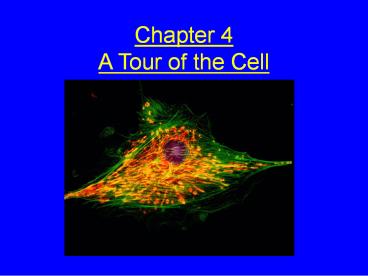Chapter 4 A Tour of the Cell - PowerPoint PPT Presentation
1 / 40
Title:
Chapter 4 A Tour of the Cell
Description:
Title: PowerPoint Presentation Author: amoriarty Last modified by: lausd_user Created Date: 8/19/2004 9:33:49 PM Document presentation format: On-screen Show (4:3) – PowerPoint PPT presentation
Number of Views:201
Avg rating:3.0/5.0
Title: Chapter 4 A Tour of the Cell
1
Chapter 4 A Tour of the Cell
2
Cytology science/study of cells
- Light microscopy
- resolving power measure of clarity
- Electron microscopy
- TEM electron beam to study cell
ultrastructure SEM electron beam to study
cell surfaces - Cell fractionation cell separation organelle
study - Ultracentrifuges cell fractionation 130,000
rpm
3
(No Transcript)
4
(No Transcript)
5
- \
6
Cell Types Prokaryotic
- Nucleoid DNA concentration
- No organelles with membranes
- Ribosomes protein synthesis
- Plasma membrane (all cells) semi-permeable
- Cytoplasm/cytosol (all cells)
7
Cell Size
- As cell size increases, the surface area to
volume ratio decreases - Rates of chemical exchange may then be inadequate
for cell size - Cell size, therefore, remains small
8
Range of Cell Size
9
Cell Fractionation
10
Nucleus
- Genetic material... chromatin chromosomes nu
cleolus rRNA ribosome synthesis - Double membrane envelope with pores
- Protein synthesis (mRNA)
11
Ribosomes
- Protein manufacture
- Free - cytosol, proteins function in cell
- Bound - endoplasmic reticulum, membranes,
organelles, and export
12
Compartmentalization
- Increases internal surface area
- Sometimes enzymes are incorporated into the
membrane. - Provide localized environmental areas.
- Sequester reactions (hydrolytic enzymes in
lysosomes)
13
The Endomembrane System
- Membranes may be interrelated directly or
indirectly via vesicles. - Membranes are dynamic structures.
- Nuclear Envelope
- Endoplasmic Reticulum
- Golgi Apparatus
- Lysosomes
- Vacuoles
- Plasma membrane (not actually a member of the
system, but related to it).
14
1. Endoplasmic Reticulum (ER)
- Continuous with nuclear envelope
- Smooth ER no ribosomes
synthesis of lipids - metabolism of carbohydrates detoxification of
drugs and - poisons
- Stores Ca2 ions
- Rough ER
- with ribosomes
- synthesis of secretory proteins
(glycoproteins), membrane production
15
Rough ER Ribosomes
- 1. Rough ER ribosomes synthesize secretory
proteins - 2. Growing polypeptide is threaded through the
ER membrane into the lumen or cisternal space - 3. Protein folds into its native conformation
- 4. Local enzymes catalyze covalent
bonding-modifications - 5. Protein departs in a transport vesicle
16
2. Golgi Apparatus
- ER products are modified, stored, and then
shipped - Cisternae flattened membranous sacs
- trans face (shipping) cis face (receiving)
- Transport vesicles
17
3. Lysosomes
- Sac of hydrolytic enzymes digestion of
macromolecules - Phagocytosis
- Autophagy recycle cells own organic material
- Tay-Sachs disease - lipid-digestion disorder
- Apoptosis
18
(No Transcript)
19
- 4.Vacuoles
- Membrane-bound sacs (larger than vesicles)
- Food vacuole
- (phagocytosis)
- Contractile (pump
- excess water)
- Central vacuole (storage in plants)
- Tonoplast (membrane)
20
Relationships Among Endomembranes
21
Other Membranous Organelles
- Not part of endomembrane system
- Peroxisomes
- Mitochondria
- Chloroplasts
22
Peroxisomes
- Single membrane
- Produce hydrogen peroxide in cells
- Metabolism of fatty acids detoxification of
alcohol (liver) - Hydrogen peroxide produced, then converted to
water action of catalase.
23
Mitochondria
- quantity in cell correlated
- with metabolic activity
- cellular respiration
- double membranous (phospholipid)
- cristae/matrix
- intermembrane space
- contain own DNA
- bacterial origin
24
Chloroplasts
- type of plastid double membranous
- thylakoids (flattened disks) grana
(stacked thylakoids) - stroma own DNA
25
The Cytoskeleton
- Fibrous network in cytoplasm
- Support, cell motility, biochemical regulation
- Microtubules thickest
- tubulin protein shape,
support, transport, chromosome separation - Microfilaments
- thinnest
- actin protein filaments
motility, cell division, shape - Intermediate filaments
- middle diameter keratin
shape, nucleus anchorage
26
(No Transcript)
27
Tubulin in endothelial cell
28
Motor Molecules and the Cytoskeleton
- motor molecules on one microtubule grab and
slide past another microtubule. - b. motor molecules attach to receptors on
organelles such as vesicles, enabling them to
walk along the microtubule
29
Centrosomes/centrioles
- Centrosome region near nucleus
- Centrioles 9 sets of triplet microtubules in a
ring used in cell replication only in animal
cells
30
Cilia/flagella
- Locomotive appendages
- Ultrastructure 92
- 9 doublets of microtubules in a ring
- 2 single microtubules in center
- connected by radial spokes
- anchored by basal body
- dynein protein
31
- ls. cilium
- cs cilium, showing 92 arrangement
- cs basal body, anchors the cilium to the cell
third - microtubule incorporated (centriole) central
2 lost
32
How Dynein walking Moves Cilia and Flagella
The dynein arms of one doublet grip the adjacent
doublet. Powered by ATP
33
(No Transcript)
34
Microfilaments and Motility
35
Cell Surfaces Junctions
- Cell wall
- not in animal cells
- protection, shape, regulation
- Plant cell
- primary cell wall produced first
- middle lamella of pectin (polysaccharide)
- holds cells together
- Some plants
- a secondary cell wall
- strong durable matrix
- wood (between plasma membrane and primary wall)
36
Extracellular Matrix (ECM)
- Glycoproteins
- proteins covalently bonded to carbohydrate
- Collagen (50 of protein in human body)
- embedded in proteoglycan (another
glycoprotein-95 carbohydrate) - Fibronectins
- bind to receptor proteins in plasma membrane
called integrins (cell communication?)
37
Intracellular Junctions
- PLANTS
- Plasmodesmata cell wall perforations
- water and solute passage in plants
- ANIMALS
- Tight junctions fusion of neighboring cells
prevents leakage between cells - Desmosomes riveted, anchoring junction strong
sheets of cells - Gap junctions cytoplasmic channels allows
passage of materials or current between cells
38
Plamodesmata in a thin plant section
39
Intercellular Junctions in Animals
40
The Lives of a CellHarvard Animation
- http//aimediaserver.com/studiodaily/videoplayer/?
srcharvard/harvard.swfwidth640height520
Narrated version
Assignment
http//www.bu.edu/histology/m/t_electr.htm
Choose 4 images to draw and label































